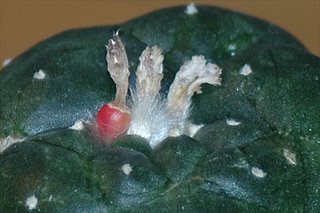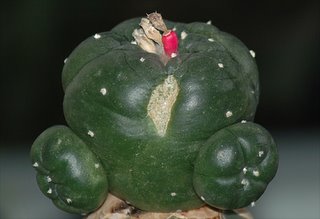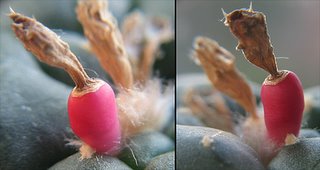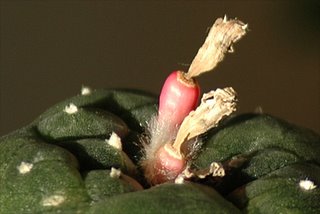Most of my plants are now dormant and I hadn’t expected much activity to report on these pages – but 5 days ago I noticed a budding fruit on my grafted Lophophora williamsii (SB 854; Starr Co, Tx).

Budding Lophophora williamsii fruit
The fruit is now ripe and slightly longer than 1 cm (~ 0.4’’) with a diameter of 4.5 mm (~ 0.2’’) at the widest section. The color is best described as a pinkish magenta segueing into a lighter pink on the surface not directly exposed to the sun.

Lophophora williamsii with ripe fruit

Lophophora williamsii fruit – close-ups
While examining the plant it became apparent that another fruit is breaking out. If this one ripens as abruptly as the last, it will be fully extruded within a week.

Fruiting Lophophora williamsii
< previous | next >
Malpighia 1927 v.30 (added: 11/24/2025)
-
*By:*
Borzi, Antonino,1852-1921.
Penzig, O.1856-1929.
Pirotta, Romualdo,1853-1936.
*Publication Info:*
Messina : g. Capra & co., 1887-89 ; Genova : Tip. di A...
1 month ago



















Were these self pollinated?
ReplyDeleteHow many seeds do you get per pod with self pollination vs. being pollinated by another Loph.?
I wanted to thank you for all the work you are doing, and sharing with us.
Yes, they were both self-pollinated.
ReplyDeleteI’m still waiting for the fruits to dry before harvesting them – the last pod contained 3 seeds.
Unfortunately I’ve been traveling a lot this season, so I only got one plant (a Lophophora williamsii v. jourdaniana) outcrossed. It hasn’t set fruit yet so I can’t compare the number of seeds (and most of my plants just started flowering so I don’t have any historical data either ;-)
Hi !and great job ! I would like to know if even the home grown lophophora williamsii contain mescalin alcaloïd ? -Because of the children around...-
ReplyDeleteWell, I can’t say for sure – but I would expect cultivated plants to have a considerable mescaline content since more and more countries are including Lophophora on their lists of controlled substances (The US, France, and Russia among others).
ReplyDeleteIf interested in cactus chemistry I can recommend Trout's Notes on Sacred Cacti. Part B (San Pedro & related Trichocereus species ) has been published by Moksha Press while parts A (Peyote & other mescaline containing cacti) and C (Cactus Alkaloids) are in the works.
Thanks a lot for this quick answer and for the links ! Again, great job with this bolg !
ReplyDeleteI thank you for your excellent web site.
ReplyDeletePerhaps this will interest you. I’ve been experimenting with different bug exterminating stuff. First note that I live in an apartment so I want to avoid using toxic stuff as my plants are in the area where I work. In spite of claims I believe the effects of exposure to these chemicals are mysterious, especially if one has to live in their vicinity.
The advice I’ve gotten was to use isopropyl (rubbing + soap) and 100% isopropyl + tobacco. I’ve tried these on mealy bugs and red spider, checked the results under my scope. Some bugs survived this and in spite of the soap as a wetting agent, it didn’t penetrate their cottony webs.
I tried different solvents and to my surprise ordinary 100% methyl alcohol sprayed on worked much better than other solvent and fast. It evaporates in very short time and penetrates any hairy sections. It can be flooded to go into the depths of large clusters. It will, as other solvents do, effect flowers (not in all cases) but it did not harm to any plant I tried it on.
Sometimes newly purchased plants had bad infestations. These have been bug free after three three-day intervals of spraying. My worst infestation of mealy bugs was on my desert rose (large and intricate) which led to endless frustration. They have been bug free for over a month now. I’ll be inspecting them very frequently.
I mention all of this because no one I spoke to mentioned methyl and anyone who can’t get his plants outside might try this as its cheap and non-toxic.
Thanks, Mani
Mani, thanks for the advice. I too aim at avoiding toxic chemicals in my living area, so I’ll add methyl alcohol to my “weaponry” the next time I need to fight spider mites or mealy bugs. I’m normally using 70% isopropyl alcohol with a bit of soap added, applied to the plants several times in intervals of three to four days.
ReplyDeleteinterested in selling a lophophora williamsii of yours? aminorex at g mail dot com
ReplyDeleteNo, I'm not selling plants or seeds; check the seed and plant retailers list to find a supplier near you ;-)
ReplyDelete